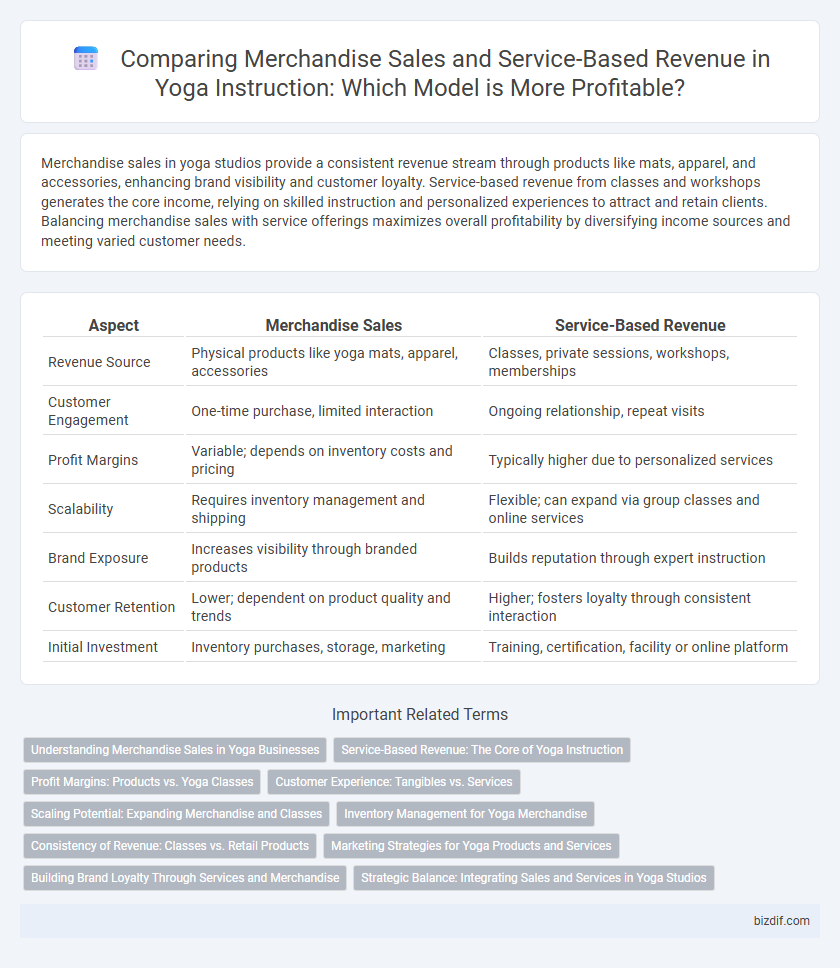Merchandise sales in yoga studios provide a consistent revenue stream through products like mats, apparel, and accessories, enhancing brand visibility and customer loyalty. Service-based revenue from classes and workshops generates the core income, relying on skilled instruction and personalized experiences to attract and retain clients. Balancing merchandise sales with service offerings maximizes overall profitability by diversifying income sources and meeting varied customer needs.
Table of Comparison
| Aspect | Merchandise Sales | Service-Based Revenue |
|---|---|---|
| Revenue Source | Physical products like yoga mats, apparel, accessories | Classes, private sessions, workshops, memberships |
| Customer Engagement | One-time purchase, limited interaction | Ongoing relationship, repeat visits |
| Profit Margins | Variable; depends on inventory costs and pricing | Typically higher due to personalized services |
| Scalability | Requires inventory management and shipping | Flexible; can expand via group classes and online services |
| Brand Exposure | Increases visibility through branded products | Builds reputation through expert instruction |
| Customer Retention | Lower; dependent on product quality and trends | Higher; fosters loyalty through consistent interaction |
| Initial Investment | Inventory purchases, storage, marketing | Training, certification, facility or online platform |
Understanding Merchandise Sales in Yoga Businesses
Merchandise sales in yoga businesses encompass the retail of yoga-related products such as mats, apparel, accessories, and wellness items, creating an additional revenue stream beyond class fees. Understanding merchandise sales helps yoga studios diversify income, enhance brand loyalty, and offer tangible value to clients while complementing service-based revenue. Effective inventory management, product selection aligned with client preferences, and integrated sales strategies boost profitability and customer engagement in the yoga industry.
Service-Based Revenue: The Core of Yoga Instruction
Service-based revenue forms the foundation of yoga instruction, relying primarily on class fees, private sessions, and workshops to generate steady income. Unlike merchandise sales, this model emphasizes personalized guidance and community building, which fosters long-term client retention and trust. Prioritizing service-based revenue enables yoga instructors to maintain a sustainable business while continuously enhancing the quality of their teaching and client experience.
Profit Margins: Products vs. Yoga Classes
Merchandise sales in yoga instruction often yield higher profit margins due to lower variable costs and the ability to scale inventory without increasing labor expenses. In contrast, revenue from yoga classes depends heavily on instructor time and class capacity, limiting scalability and resulting in comparatively lower profit margins. Optimizing profit involves balancing merchandise offerings like mats and apparel with high-demand, well-priced classes to maximize overall revenue streams.
Customer Experience: Tangibles vs. Services
Merchandise sales in yoga studios provide tangible products such as mats, apparel, and accessories that enhance customers' practice and create a physical connection to the brand. Service-based revenue focuses on intangible experiences including personalized instruction, class variety, and community building that drive long-term client satisfaction and loyalty. Balancing merchandise quality with exceptional service delivery optimizes overall customer experience, boosting retention and profitability.
Scaling Potential: Expanding Merchandise and Classes
Expanding merchandise sales alongside yoga classes significantly enhances scaling potential by diversifying revenue streams and reaching broader markets. Physical products like branded mats and apparel offer passive income opportunities, while increasing class offerings and online sessions boosts service-based revenue and client engagement. Combining both approaches creates a sustainable growth model that maximizes profitability and brand presence.
Inventory Management for Yoga Merchandise
Efficient inventory management is crucial for maximizing merchandise sales in yoga instruction by ensuring the availability of high-demand items such as mats, apparel, and accessories. Accurate tracking systems help reduce overstock and stockouts, directly impacting profitability and customer satisfaction. Balancing inventory levels enables yoga studios to optimize revenue streams alongside service-based income from classes and workshops.
Consistency of Revenue: Classes vs. Retail Products
Service-based revenue from yoga classes generates consistent monthly income due to scheduled sessions and recurring memberships. Merchandise sales, such as yoga mats and apparel, often result in fluctuating revenue influenced by seasonal demand and inventory availability. Stable cash flow is typically more achievable through class subscriptions compared to one-time retail purchases.
Marketing Strategies for Yoga Products and Services
Marketing strategies for yoga products often emphasize the tangible benefits of merchandise such as eco-friendly mats, apparel, and accessories, leveraging social media campaigns and influencer partnerships to boost sales. Service-based revenue, including classes and workshops, relies on targeted content marketing, community-building, and personalized experiences to enhance client retention and upsell opportunities. Combining both approaches by integrating branded merchandise into service offerings can maximize overall profitability and brand loyalty in the yoga industry.
Building Brand Loyalty Through Services and Merchandise
Yoga studios generate diverse income streams by balancing merchandise sales with service-based revenue such as classes and workshops. Offering high-quality yoga apparel, mats, and accessories alongside personalized instruction enhances customer engagement and reinforces brand loyalty. Integrating exclusive merchandise with tailored wellness services creates a seamless experience that encourages repeat business and strengthens community connections.
Strategic Balance: Integrating Sales and Services in Yoga Studios
Yoga studios achieve sustainable growth by strategically balancing merchandise sales and service-based revenue, enhancing overall profitability. Offering high-quality yoga gear and apparel complements class offerings, creating a seamless customer experience that boosts brand loyalty. Integrating personalized instruction with carefully curated product lines maximizes revenue streams while meeting diverse client needs.
Merchandise sales vs Service-based revenue Infographic

 bizdif.com
bizdif.com